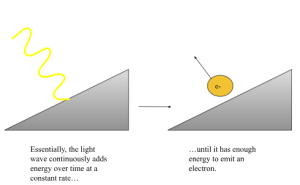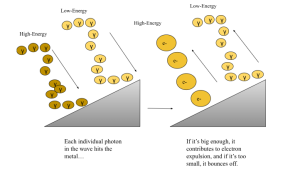A Brief History of Modern Physics
Written by: Karthik Prasad
The 19th and 20th centuries gave physicists a glimpse into the true underpinnings of the universe itself: modern physics. Three major theories emerged in this time period–special relativity, quantum mechanics, and general relativity. This article aims to overview the historical motivation and development of these theories and describe the current direction of the fields going forth.
Special Relativity (1)
Newtonian Physics makes the assumption that all non-accelerating observers see things in the same way, plus or minus the velocity difference between the two frames. Notably, this means that if we have two observers moving at different speeds, they should see that the speed of light, or more scientifically the speed of photons, is different.
But, the Michelson-Morley experiment showed that this was not the case, and therefore, that the assumption that all reference frames see things plus or minus a constant is wrong. Combined with the predictions of Maxwell’s equations of electromagnetism of the motion of electromagnetic waves, this led Einstein to realize that the speed of light is constant in all reference frames, and makes it possible to connect the predictions of different observers together. We can use mathematics together with this assumption to derive the phenomena of time dilation and length contraction, which tell us that two people in different reference frames experience time and length differently.
Quantum Mechanics (2)
The primary experimental evidence and motivation for the development of quantum mechanics comes from the photoelectric effect. Classical physics (which assumes that light is a wave) predicts that light transfers energy when it hits metal at a constant rate (because it is a uniform wave). When the metal absorbs enough energy, the electrons in the metal atoms beco me excited, and the metal emits an electron to return to a stable state. This implies that if the light transfers energy for long enough, then the metal will always eventually be able to emit an electron.
Figure 1

A Diagram Indicating the Classical Interpretation of Light and the Photoelectric Effect
Source: [Original Work]
However, experimental evidence showed that low-intensity light would never emit an electron, no matter how long it was exposed. Albert Einstein proposed that light was actually a set of photons arranged like a wave, where each photon had a certain amount (called a quanta) of energy associated with it. Then, if the photon’s energy was too low, it would just bounce off the metal, and if it was very high, each individual photon would trigger emission, even if there were only a small number of them.
Figure 2

Depiction of Modern-Interpretation of Photoelectric Effect
Source: [Original Work]
This is called wave-particle duality and led physicists to ask, “What other particles are quantized?” This inspires the development of wave-functions and the remainder of quantum physics.
General Relativity (3)
The formation of the theory of general relativity follows from the ideas behind special relativity. Einstein’s postulate of special relativity states that nothing can transfer faster than the speed of light—including information about physical phenomena. However, Newtonian gravity states that the force of gravity changes instantly as the distance between two objects changes—contradicting the idea that “instantaneous” change from a distance is impossible.
The solution to this paradox came from weightlessness. When a person is falling freely in an elevator, they feel weightless—they cannot observe the gravitational force acting on them. However, if we interpret gravity as merely the linear acceleration of OTHER objects toward the person, the paradox of gravity can be avoided entirely. This is called the principle of equivalence. The rest of general relativity follows from mathematics that describe this principle of equivalence.
Figure 3

The Weightlessness Phenomenon
Source: (3)
Conclusion
The theories of special relativity, quantum mechanics, and general relativity—describing high-speed motion, elementary particles, and gravitation—form the basis of modern physics. In the future, physicists can continue to use these tools to explore the universe further through techniques like quantum field theory, semiclassical gravity, and more.
References and Sources:
Source 1 “5.4: Photoelectric Effect.” Chemistry LibreTexts, Libretexts, 20 Sept. 2022, chem.libretexts.org/Bookshelves/Introductory_Chemistry/Introductory_Chemistry_(CK-12)
Source 2 “The Foundations of Special Relativity – George Mason University.” PHYS428 Lecture Notes, George Mason University, physics.gmu.edu/~joe/PHYS428/Topic2.pdf. Accessed 30 Aug. 2023.
Source 3 10, M. D. F. (2022, December 30). How Einstein arrived at his theory of general relativity. Literary Hub. https://lithub.com/how-einstein-arrived-at-his-theory-of-general-relativity/
1 thoughts on “A Brief History of Modern Physics”